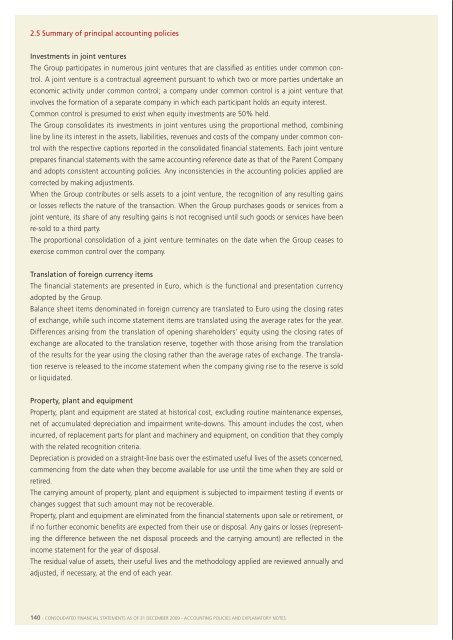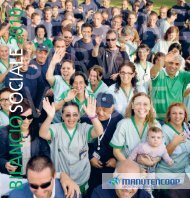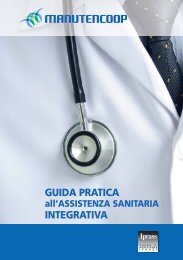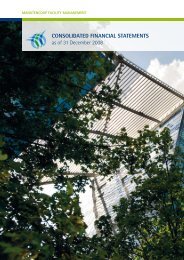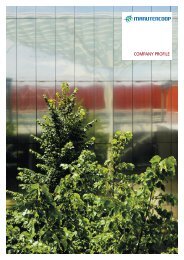Financial Statements 2009 - Manutencoop
Financial Statements 2009 - Manutencoop
Financial Statements 2009 - Manutencoop
Create successful ePaper yourself
Turn your PDF publications into a flip-book with our unique Google optimized e-Paper software.
2.5 summary of principal accounting policiesinvestments in joint venturesthe group participates in numerous joint ventures that are classified as entities under common control.a joint venture is a contractual agreement pursuant to which two or more parties undertake aneconomic activity under common control; a company under common control is a joint venture thatinvolves the formation of a separate company in which each participant holds an equity interest.Common control is presumed to exist when equity investments are 50% held.the group consolidates its investments in joint ventures using the proportional method, combiningline by line its interest in the assets, liabilities, revenues and costs of the company under common controlwith the respective captions reported in the consolidated financial statements. each joint ventureprepares financial statements with the same accounting reference date as that of the parent Companyand adopts consistent accounting policies. any inconsistencies in the accounting policies applied arecorrected by making adjustments.When the group contributes or sells assets to a joint venture, the recognition of any resulting gainsor losses reflects the nature of the transaction. When the group purchases goods or services from ajoint venture, its share of any resulting gains is not recognised until such goods or services have beenre-sold to a third party.the proportional consolidation of a joint venture terminates on the date when the group ceases toexercise common control over the company.translation of foreign currency itemsthe financial statements are presented in euro, which is the functional and presentation currencyadopted by the group.balance sheet items denominated in foreign currency are translated to euro using the closing ratesof exchange, while such income statement items are translated using the average rates for the year.differences arising from the translation of opening shareholders’ equity using the closing rates ofexchange are allocated to the translation reserve, together with those arising from the translationof the results for the year using the closing rather than the average rates of exchange. the translationreserve is released to the income statement when the company giving rise to the reserve is soldor liquidated.property, plant and equipmentproperty, plant and equipment are stated at historical cost, excluding routine maintenance expenses,net of accumulated depreciation and impairment write-downs. this amount includes the cost, whenincurred, of replacement parts for plant and machinery and equipment, on condition that they complywith the related recognition criteria.depreciation is provided on a straight-line basis over the estimated useful lives of the assets concerned,commencing from the date when they become available for use until the time when they are sold orretired.the carrying amount of property, plant and equipment is subjected to impairment testing if events orchanges suggest that such amount may not be recoverable.property, plant and equipment are eliminated from the financial statements upon sale or retirement, orif no further economic benefits are expected from their use or disposal. any gains or losses (representingthe difference between the net disposal proceeds and the carrying amount) are reflected in theincome statement for the year of disposal.the residual value of assets, their useful lives and the methodology applied are reviewed annually andadjusted, if necessary, at the end of each year.the useful lives of the various categories of property, plant and equipment are estimated on the followingbasis:type of plant and equipmentuseful lifeplant and machinery for maintenance/creation of green areas11 yearsplant and machinery for maintenance/construction of propertyfrom 6.5 to 10 yearstelephone equipment4 yearsequipment for cleaning and green area6.5 yearsequipment for managing technological installations3 yearsequipment for maintenance/construction of property2.5 yearsother industrial and commercial equipment10 yearslaundry equipment8 yearslinenfrom 2.5 to 4 yearsVehiclesfrom 4 to 5 yearsoffice furniture and equipmentfrom 5 to 8 yearsleasehold improvements (included in plant and equipment)lower of useful life and contract durationin addition to plant and equipment in the strict sense, this category also includes machinery, motorvehicles, office machines and furniture.purchasing-related borrowing costs are charged to the income statement unless they are directly attributableto the purchase, construction or production of a qualifying asset that justifies their capitalisation,in which case they are capitalised.a qualifying asset is an asset that necessarily requires a substantial period of time before it becomesavailable for use.the capitalisation of borrowing costs ceases when essentially all the activities needed to render a qualifyingasset available for use have been completed.improvement expenditure is only added to the carrying amount of the asset concerned if it is likelythat the related future economic benefits will accrue to the company and the costs can be determinedreliably. the cost of repairs, maintenance and other work to keep assets operational are charged to theincome statement as incurred.leasehold improvements are classified as part of property, plant and equipment, depending on thenature of the costs incurred, when they fulfil the capitalisation criteria established in ias 16. they aredepreciated over the residual life of the tangible asset concerned or the residual duration of the leasecontract, whichever is shorter.Goodwillthe goodwill arising from business combinations is initially measured at cost, being the differencebetween acquisition cost and the group’s interest in the net fair value of the related assets, liabilitiesand contingent liabilities. after initial recognition, goodwill is measured at cost net of any accumulatedimpairment losses. goodwill is subjected to impairment testing on an annual basis, or more frequentlyif events or changes suggest that it may not be fully recoverable.for impairment testing purposes, goodwill is allocated from the date of acquisition to each of thegroup’s cash-generating units that are expected to benefit from the synergies released from the acquisition,regardless of the allocation of other assets or liabilities to the same units. this is only done ifsuch allocation is not arbitrary. each unit to which goodwill is allocated:> represents the lowest level, within the group, at which goodwill is monitored for internal operationalpurposes;140 - Consolidated finanCial statements as of 31 deCember <strong>2009</strong> - aCCounting poliCies and explanatory notes Consolidated finanCial statements as of 31 deCember <strong>2009</strong> - aCCounting poliCies and explanatory notes - 141


